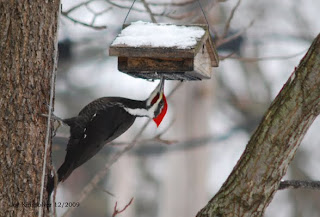 Joining our party this week, but keeping pretty much to themselves, were Mr. and Mrs. Big Bird, our pileated woodpecker visitors. We've watched for them every winter for several years. Usually they show up in January, but this year they came at the beginning of December, rather early. (The photo on the right shows the female.)
Joining our party this week, but keeping pretty much to themselves, were Mr. and Mrs. Big Bird, our pileated woodpecker visitors. We've watched for them every winter for several years. Usually they show up in January, but this year they came at the beginning of December, rather early. (The photo on the right shows the female.)A couple of weeks ago, I watched as the male landed on the walnut tree and helped himself to the suet. He ate for awhile, and then, just before taking off, called loudly 3 or 4 times. I waited, and, sure enough, the female came by and had her own breakfast. (I noticed that he waited to call her until he was full himself, but still, it was nice to see him looking out for her.) Pileateds mate for life, and they defend their territory together year-round. Often, they come to our feeders together or within a few minutes of each other. Below is the male, with the distinctive red "moustaches."

The other day I bought a 1958 children's book on birds called "Birds of the World: An Introduction to the Study of Birds" (Golden Library of Knowledge). I do a little collecting of nature writing of the past, and this is the first children's nature book I've bought.

It's interesting that the page on woodpeckers focuses on the Ivory-billed woodpecker, extinct even in 1958. And how do woodies do all that drumming without hurting themselves? The title of the page, "Hard Heads," is somewhat misleading, but the book correctly explains that "the bony structure of the woodpecker's head...is shaped to resist the shock of the constant hammering."
As a child I was told that woodpeckers had very hard heads, but although it's true that
I don't remember learning much about birds as a child, but we had one or two nature books that I studied for hours. I think they had something to do with my love of birds -- including those wonderful woodies. I wonder how many birders of today were inspired by this little book of yesteryear?














